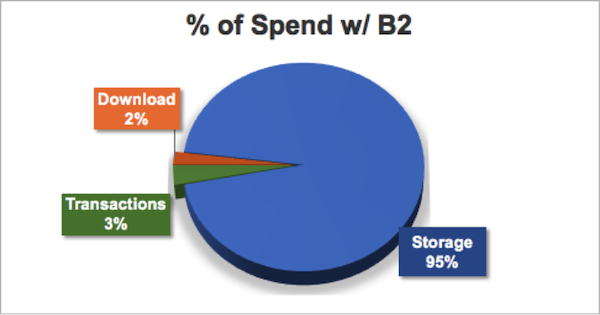
Editor’s Note
This post reflects Backblaze B2 Cloud Storage pricing at the time it was published. We’ve since shared more recent price and product updates.
Predicting your cloud storage cost should be easy. After all, there are only three cost dimensions: 1) storage (the rental for your slice of the cloud), 2) download (the fee to bring your data out of the cloud), and 3) transactions (charges for “stuff” you might do to your data inside the cloud). Yet, you probably know someone (you?) that was more than surprised when their cloud storage bill arrived. They have good company, as according to ZDNet, 37% of IT executives found their cloud storage costs to be unpredictable.
Here are five tips you can use when doing your due diligence on the cloud storage vendors you are considering. The goal is to create a cloud storage forecast that you can rely on each and every month.
Tip # 1 — Don’t Miscalculate Progressive (or is it Regressive?) Pricing Tiers
The words “Next” or “Over” on a pricing table are never a good thing.
Standard Storage Pricing Example
- First 50 TB / Month $0.026 per GB
- Next 450 TB / Month $0.025 per GB
- Over 500 TB / Month $0.024 per GB
Those words mean there are tiers in the pricing table which, in this case, means you have to reach a specific level to get better pricing. You don’t get a retroactive discount — only the data above the minimum threshold enjoys the lower price.
The mistake sometimes made is calculating your entire storage cost based on the level for that amount of storage. For example, if you had 600 TB of storage, you could wrongly multiply as follows:
(600,000 x 0.024) = $14,400/month
When, in fact, you should do the following:
(50,000 x 0.026) + (450,000 x 0.025) + (100,000 x 0.024) = $15,150/month
That was just for storage. Make sure you consider the tiered pricing tables for data retrieval as well.
Tip # 2 — Don’t Choose the Wrong Service Level
Many cloud storage providers offer multiple levels of service. The idea is that you can trade service capabilities for cost. If you don’t need immediate access to your files or don’t want data replication or eleven 9s of durability, there is a choice for you. Besides giving away functionality, there’s a bigger problem. You have to know what you are going to do with your data to pick the right service because mistakes can get very expensive. For example:
- You choose a low cost service tier that normally takes hours or days to restore your data. What can go wrong? You need some files back immediately and you end up paying 10-20 times the cost to expedite your restore.
- You choose one level of service and decide you want to upload some data to a compute-based application or to another region — features not part of your current service. The good news? You can usually move the data. The bad news? You are charged a transfer fee to move the data within the same vendor’s infrastructure because you didn’t choose the right service tier when you started. These fees often eradicate any “savings” you had gotten from the lower priced tier.
Basically, if your needs change as they pertain to the data you have stored, you will pay more than you expect to get all that straightened out.
Tip # 3 — Don’t Pay for Deleted Files
Some cloud storage companies have a minimum amount of time you are charged for storage for each file uploaded. Typically this minimum period is between 30 and 90 days. You are charged even if you delete the file before the minimum period. For example (assuming a 90 day minimum period), if you upload a file today and delete the file tomorrow, you still have to pay for storing that deleted file for the next 88 days.
This “feature” often extends to files deleted due to versioning. Let’s say you want to keep three versions of each file, with older versions automatically deleted. If the now deleted versions were originally uploaded fewer than 90 days ago, you are charged for storing them for 90 days.
Using a typical backup scenario let’s say you are using a cloud storage service to store your files and your backup program is set to a 30 day retention. That means you will be perpetually paying for an additional 60 days worth of storage (for files that were pruned at 30 days). In other words, you would be paying for a 90 day retention period even though you only have 30 days worth of files.
Tip # 4 — Don’t Pay For Nothing
Some cloud storage vendors charge a minimum amount each month regardless of how little you have stored. For example, even if you only have 100 GB stored you get to pay like you have 1 TB (the minimum). This is the moral equivalent of a bank charging you a monthly fee if you don’t meet the minimum deposit amount.
Continuing on the theme of paying for nothing, be on the lookout for services that charge a minimum amount per each file stored regardless of how small the file is, including zero bytes. For example, some storage services have a minimum file size of 128K. Any files smaller than that are counted as being 128K for storage purposes. While the additional cost for even a couple of million zero-length files is trivial, you’re still being charged something for nothing.
Tip # 5 — Be Suspicious of the Fine Print
Misdirection is the art of getting you to focus on one thing so you don’t focus on other things going on. Practiced by magicians and some cloud storage companies, the idea is to get you to focus on certain features and capabilities without delving below the surface into the fine print.
Read the fine print and as you stroll through the multi-page pricing tables and linked pages of all of the rules that shape how you can use a given cloud storage service. Stop and ask, “what are they trying to hide?” If you find phrases like: “we reserve the right to limit your egress traffic,” or “new users gets free usage tier for 12 months,” or “provisioned requests should be used when you need a guarantee that your retrieval capacity will be available when you need it,” take heed.
How to Build a Predictable Cloud Storage Budget
As we noted previously, cloud storage costs are composed of three dimensions: storage, download and transactions. These are the cost drivers for cloud storage providers, and as such are the most straightforward way for service providers to pass on the cost of the service to its customers.
Let’s start with data storage as it is the easiest for a company to calculate. For a given month data storage cost is equal to:
Take that total and multiple by the monthly storage rate and you’ll get your monthly storage costs.
Computing download and transaction costs can be harder as these are variables you may have never calculated before, especially if you previously were using in-house or LTO-based storage. To help you out, below is a chart showing the breakdown of the revenue from Backblaze B2 Cloud Storage over the past 6 months.
As you can see, download (2%) and transaction (3%) costs are, on average, minimal compared to storage costs. Unless you have reason to believe you are different, using these figures is a good proxy for your costs.
Let’s Give it a Try
Let’s start with 100 TB of original storage then add 10 TB each month and delete 5 TB each month. That’s 105 TB of storage for the first month. Backblaze has built a cloud storage calculator that computes costs for all of the major cloud storage providers. Using this calculator, we find that Amazon S3 would cost $2,205.50 to store this data for a month, while Backblaze B2 would charge just $525.10.
Using those numbers for storage and assuming that storage will be 95% of your total bill (as noted in the chart above), you get a total monthly cost of $2,321.05 for Amazon S3 and Backblaze B2 will be $552.74 a month.
The chart below provides the breakdown of the expected cost.
| Backblaze B2 | Amazon S3 | |
| Storage | $525.10 | $2,205.50 |
| Download | $11.06 | $42.22 |
| Transactions | $16.58 | $69.33 |
| Totals: | $552.74 | $2,321.05 |
Of course each month you will add and delete storage, so you’ll have to account for that in your forecast. Using the cloud storage calculator noted above, you can get a good sense of your total cost over the budget forecasting period.
Finally, you can use the Backblaze B2 storage calculator to address potential use cases that are outside of your normal operation. For example, you delete a large project from your storage or you need to download a large amount of data. Running the calculator for these types of actions lets you obtain a solid estimate for their effect on your budget before they happen and lets you plan accordingly.
Creating a predictable cloud storage forecast is key to taking full advantage of all of the value in cloud storage. Organizations like Austin City Limits, Fellowship Church, and Panna Cooking were able to move to the cloud because they could reliably predict their cloud storage cost with Backblaze B2. You don’t have to let pricing tiers, hidden costs and fine print stop you. Backblaze makes predicting your cloud storage costs easy.



